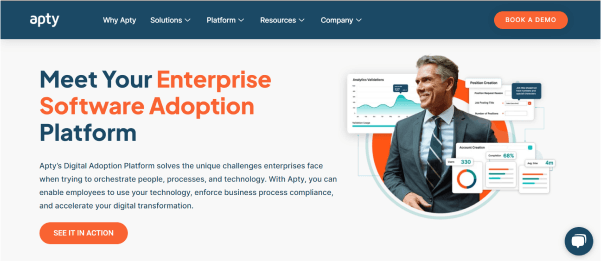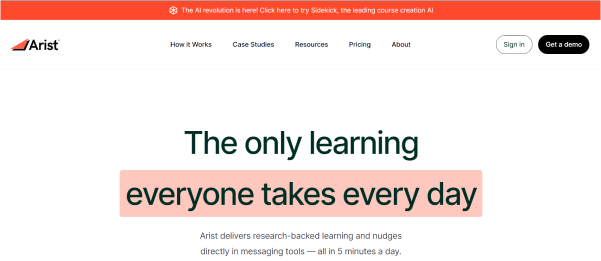13 Remote training software for 2024
Published
January 3, 2024
Author
Share

Remote training allows for continuous learning without the usual time and location restraints. This trumps traditional face-to-face training since learners don’t have to be in one place. They’ll also have access to learning materials whenever they need them.
Using remote training software to shift to remote work guarantees that your dispersed workforce still receives efficient training and resources to succeed in their roles. It also lets you have flexibility in creating, storing, delivering, and managing content for employee training.
What are the advantages of remote training?
Remote training is also known as online or virtual training. It offers several advantages that make it an increasingly popular choice for individuals and organizations:
- Flexibility: Remote training allows learners to access training materials from any location as long as they have internet access. This benefits teams that are spread across various locations.
- Reduced Costs: Remote training helps companies save on travel expenses, accommodation, and other related costs.
- Time Savings: Learners can avoid the time spent commuting to and from a training location. This lets them use that time in more productive ways.
- Flexible Scheduling: Remote training often offers more flexibility in scheduling, allowing people to choose time slots that suit their individual or team needs.
- Tailored Learning Paths: Remote training platforms often allow for more personalized and adaptive learning experiences. This allows learners to focus on specific topics or skills relevant to their needs.
- Interactive Tools: Remote training platforms use interactive tools, multimedia resources, and collaboration features to enhance the learning experience.
- Real-time Feedback: Learners can receive instant feedback through online assessments, quizzes, and interactive exercises.
- On-Demand Access: Recorded training sessions can be accessed later, allowing learners to review content or catch up on missed sessions at their convenience.
- Easier Scaling: Organizations can more easily scale training programs to accommodate larger numbers of participants without the logistical challenges associated with in-person training.
- Increased Engagement: Remote training can lead to higher levels of engagement since employees have more control over their learning environment. They can also interact in ways that suit their preferences.
While remote training offers numerous advantages, you should also consider potential challenges. These include the need for a reliable internet connection, potential distractions, and the importance of maintaining a sense of community and collaboration among participants.
To offer these advantages and address potential challenges, we’ve compiled a list of remote training software to help you get started with your team’s remote training journey.
1. EdApp
EdApp is a mobile-first remote training software that gives you the flexibility to create and deliver digital training content anytime, anywhere. With its free and customizable course library, you can tailor courses and lessons to align with your organization's needs.

Its virtual classrooms are designed to enhance remote training by facilitating social interaction and making successful virtual learning environments. Video meetings in courses also promote collaborative discussions for the exchange of ideas, knowledge, and experiences.

Plus, setting up conferences is seamless and compatible with popular third-party platforms like Zoom and Microsoft Teams. As a cloud-based learning solution, EdApp empowers learners to access training materials from their phones, making it the perfect choice for remote learning.
EdApp's AI Create feature is incredibly useful for remote training as it streamlines the course-building process. With a simple prompt, you can use this artificial intelligence tool to generate interactive training content for your team.

Cost: Free
Rating: 4.7/5
Best for: Mobile learning for remote teams
Pros:
- Free and customizable courses
- Collaborative virtual classrooms
- Cloud-based, mobile-first learning environment
Cons:
- No option to send newsletters to selected accounts only
Sign up for free and start using the best remote training software today!
2. Braincert
BrainCert is a mobile-friendly employee training software that allows companies to deliver online training. With its virtual classroom feature, learners can log in to their LMS and attend instructor-led classes remotely.

The platform offers comprehensive blended-learning features similar to other learning management systems such as video streaming & chat, analytics, and reporting. BrainCert also allows content management for smooth onboarding experiences.
Cost: 39 USD monthly
Rating: 4.3/5
Best for: Global startup training
Pros:
- Online learning through virtual classrooms
- Blended learning via chat and streaming
- Analytics and reporting
- Content management
Cons:
- Minimal flexibility when customizing courses
- Overwhelming features
- Hard-to-reach customer support
3. Google Classroom
Google Classroom is a popular platform for remote learning. Through this technology, trainers can create a “classroom” where employees can take different training sessions and access lectures assigned to them.

You can even designate different creative projects and hands-on learning to keep your learners engaged. It can also be used with Google Meet, Google Docs, and the like for a more streamlined experience.
While this platform’s free of charge, Google Classroom lacks the bells and whistles that come with other tools that allow for more customization to make it visually appealing.
Cost: Free
Rating: 4.6/5
Best for: School education
Pros:
- Popular virtual learning platform
- Creative projects and hands-on learning activities
- Seamless Google Suite integration
Cons:
- Lacks customization options
- Doesn’t allow for in-platform chats between teachers and students
- No standards-based grading system
4. Kahoot!
Kahoot! is another remote training software that you can use to spice up your online training sessions. It’s a game-based learning platform that allows you to create training content with gamification examples. These include interactive games and quizzes to help drive interest and engagement no matter where your learners are.

With Kahoot!, you can deliver training, meetings, demonstrations, and events remotely, which can be presented on the employees’ own devices. Another way to keep your teams connected and up to date is by hosting live kahoots over the video conferencing platform of your choice to combat learner isolation.
Kahoot! also provides reporting and analytics so that knowledge gaps can be spotted and feedback can be given for a more holistic training experience.
Cost: Starts at 17 USD monthly
Rating: 4.7/5
Best for: Gamified remote learning
Pros:
- Interactive game-based format
- Live kahoots
- Reporting & analytics
Cons:
- Unreliable data tracking over a long period of time
- Not ideal for pinpointing actual knowledge gaps
5. Arlo
Arlo’s a remote work training software that focuses on empowering learners through self-paced online learning. It extends training outside the four walls of the classroom through interactive webinars, eLearning modules, discussion forums, and video tutorials.

With Arlo, you can create modules that your learners can complete in their own time, online. You’ll also be able to assign quizzes, record scores, and track progress. Arlo’s base plan only offers basic features and its price goes up with more access to their premium features.
Cost: Starts at 179 USD monthly
Rating: 4.7/5
Best for: Paperless training management
Pros:
- Self-paced elearning
- Live webinars and recorded video tutorials
- Assessments and progress tracking
Cons:
- Complicated discount structure for larger teams
- Inefficient user interface
6. Trainual
Trainual is another remote training software that you can use to onboard new employees or train current team members without location restrictions. You can easily customize learning materials by choosing from the platform’s 150+ free templates.

When creating an elearning program, you’ll have the option of embedding online flashcards, images, videos, and multiple-choice questions. However, it doesn’t support SCORM files or other eLearning formats, which can be a deal-breaker for those with existing content on other platforms.
Trainual highlights the importance of process and procedure documentation so they also provide playbook templates for training to become infinitely repeatable and scalable. Your employees can also access remote programs through multiple online course platforms, including iOS, Android, Chrome extension, and any web browser.
Cost: Starts at 250 USD monthly
Rating: 4.8/5
Best for: Small businesses with less than 100 employees
Pros:
- Customizable course templates
- Seamless image, video, and quiz experience
- Accessible via iOS, Android, and web browsers
Cons:
- Lacks customization features
- Not SCORM compliant
- Burdensome setup process
7. Apty
Apty is a training software that aims to provide high-impact, remote employee training. It allows you to build and maintain training materials with ease through its code-free course editor and course management features.

One of its standout features is on-demand on-screen guidance, which effectively enhances the remote training experience. It also lets you present training material to your learners step-by-step as if they’re guided by a trainer who’s just sitting right next to them.
Cost: Contact Apty
Rating: 4.7/5
Best for: Enterprise training
Pros:
- Code-free course editors
- Convenient course management features
- On-screen guided training
Cons:
- Pricing details could be more transparent
- Sometimes needs custom scripts for linking
8. WizIQ
WizIQ is a remote training software that gives you a virtual classroom and LMS all in one place. To increase learner engagement, you’ll have access to polls, quizzes, and interactive whiteboards.

This online training platform makes training remote workers easy. All you have to do is set up your customizable learning portal and upload your training material using any format. WizIQ also supports multimodal learning where you have the option to use real-time audio, video, and text communication.
Through its virtual classroom, learners can also attend live classes on the go through the WizIQ app available on iOS and Android.
Cost: Contact WizIQ
Rating: 3.5/5
Best for: Online teaching and training
Pros:
- 2-in-1 Virtual classroom and elearning mobile app
- Interactive polls, quizzes, and whiteboards
- Multimodal virtual classroom
Cons:
- Software failures
- Ineffective refund system
- App stalling
- Unreliable flash
9. Kitaboo Insight
Kitaboo Insight is a remote training software designed for delivering training through mobile devices. It’s compatible with all devices, whether it’s iOS or Android. It allows you to seamlessly integrate with the LMS you already use for a smooth transition to their software.

Using Kitaboo Insight is as easy as uploading your existing training content and adding quizzes and knowledge checks with their pre-built templates. You can then upload training material securely with DRM protection and even have offline access to your content.
One of its unique features is the ability to convert static PDF, PowerPoint, and text files into interactive digital content. It’s perfect for learners with short attention spans who may have trouble going through long documents.
Cost: Contact Kitaboo
Rating: 4.7/5
Best for: Interactive training
Pros:
- Mobile-first training design
- Seamless LMS integration
- Interactive digital content
Cons:
- Not the most user-friendly
10. Yarno
Yarno is a remote training software that can train your employees wherever they’re located. It features a learning library where your training teams and learners can store all your training content for easy access.

It also has an interesting Embed feature where quick quizzes can be rolled out over a certain period and completed daily to check for learning. You can also ask questions so learners can come up with answers that strengthen the recall of information.
Then, you can follow up with explanations and feedback for their answers. Yarno’s team can also work with you to create custom-made videos to level up your employees’ skills.
Cost: Contact Yarno
Rating: 4.8/5
Best for: Team-based microlearning
Pros:
- Expansive learning library
- Embed quiz feature
- Timely explanations and feedback
- Custom-made training videos
Cons:
- Spammy email prompts
- Significant non-participation rates
- Missing features mid-campaign
11. Qstream
Qstream is a microlearning platform offering distance learning initiatives that address the forgetting curve and boost knowledge retention through virtual learning experiences. This tool strengthens understanding, cultivates skills, and increases productivity through a mobile-first strategy.

Its Content Hub feature empowers you to develop diverse learning content and tutorials using a template library and a set of guide questions on its online training platform. Plus, it supports real-time skill reinforcement with an analytics dashboard while proficiency maps track and visualize learning progress effectively.
Cost: Contact Qstream
Rating: 4.5/5
Best for: Individualized employee learning
Pros:
- Virtual distance learning
- Mobile-first training
- Content hub with a template library
- Analytics dashboard and proficiency maps
Cons:
- No custom report feature
- Limited features without licensing
- Lacks self-creation and self-directed streams
12. Arist
Arist is an inventive tool that uses text-based learning strategies for training. The process of crafting and dispatching a text course through Arist mirrors the simplicity of composing a standard text message.

Typically, these text message courses consist of an image, a concise 1,200-character explanation of a crucial concept, and an interactive assessment. Although this approach addresses learning obstacles, particularly for individuals with unreliable internet access, its drawback lies in its character limitations per text message.
The platform also lacks formatting options, restricting its ability to deliver visually appealing and engaging content.
Cost: Starts at 9 USD monthly per user
Rating: 4.8/5
Best for: Messaging-based learning
Pros:
- Simple, text-based learning
- Interactive assessment
Cons:
- Restrictive character limitations
- Lacks formatting options
13. LearnWorlds
LearnWorlds revolutionizes remote learning by offering a captivating and interactive experience for learners. It easily departs from the conventional modules typically presented in PDF or PowerPoint formats.

This distance learning solution empowers you to generate training content while using the platform's themes and styles to transform it into visually compelling online courses. You can also incorporate self-improvement quizzes, formal tests, and assignments to increase learners’ confidence and improve retention of information.
To enhance the learning experience, the platform supports casual reading with features like note-taking and highlighting, for improved comprehension and engagement.
Cost: Starts at 24 USD monthly
Rating: 4.6/5
Best for: Online course creation and selling
Pros:
- Visually compelling online courses
- Quizzes, tests, and assignments
- Casual reading features
Cons:
- Lack of student authentication
- Increasingly unresponsive support through time
What is remote training?
Remote training is the most ideal and practical solution to reach and train teams across different locations and time zones. It especially soared during the COVID-19 global pandemic, which pushed thousands of businesses to shift to remote training. This was needed to sustain a culture of growth and learning as teams were forced to stay at home and work remotely.
However, with the existing distance and lack of physical interaction from coaches or colleagues, keeping learners engaged can be challenging. By investing in remote training software, you can leverage features that are designed to increase engagement and productivity in distance learning.
Author
Donna Dane
Donna is an elearning content writer for EdApp, a mobile-based microlearning platform designed for today's digital training needs. When she's not writing web articles, she writes lines of code or songs or anything food-related.

